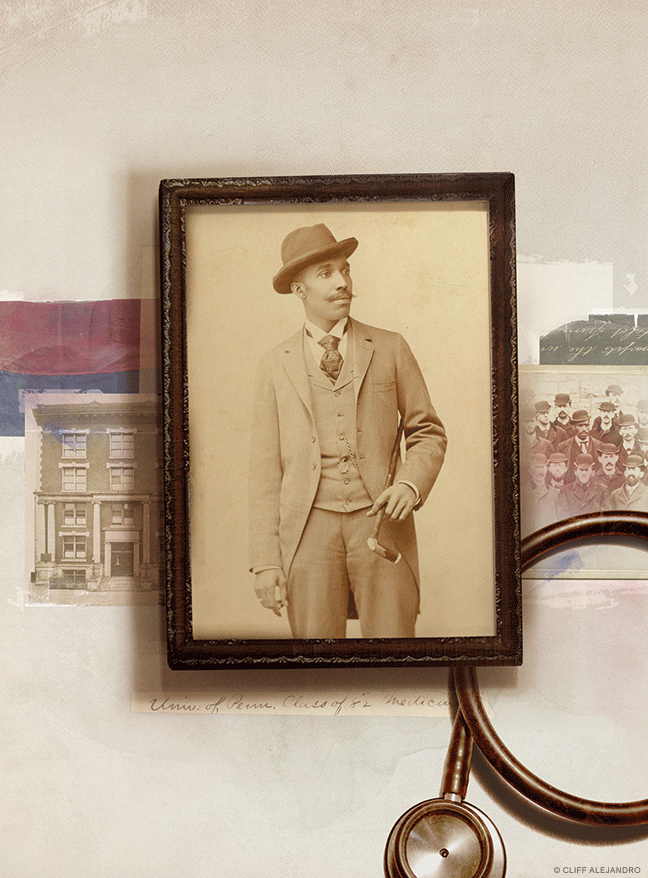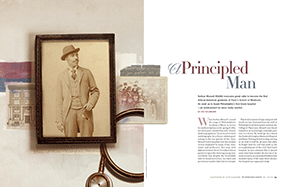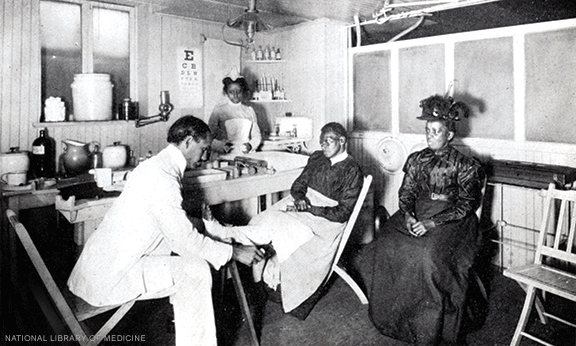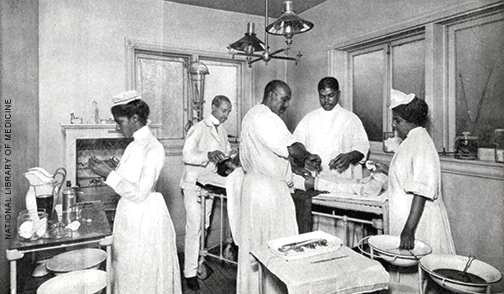
Nathan Mossell M1882 overcame great odds to become the first African-American graduate of Penn’s School of Medicine. He went on to found Philadelphia’s first black hospital—an achievement he never really wanted.
BY EVI HEILBRUNN | Illustration by Cliff Alejandro

When Nathan Mossell crossed the stage of Philadelphia’s Academy of Music to receive his medical diploma in the spring of 1882, his white peers saluted him with “almost deafening applause,” he wrote in his short autobiography. As an honor student graduating in the top quarter of his class, Mossell had triumphed over the virulent racism displayed by many of his classmates and professors. But now, with diploma in hand, Penn’s first black doctor gazed out upon the cheering young men, confident that despite the formidable odds he would surely face, his talent and persistence would enable him to triumph.
That brief moment of hope and good will would not last. Excluded from the staff of Philadelphia’s white hospitals and from the College of Physicians, Mossell soon found himself in an increasingly untenable position as a doctor. He would go on to found the Frederick Douglass Memorial Hospital and Nurse Training School in 1895, serving as its chief of staff for 38 years. But while he fought hard for, and took pride in, the accomplishments of the city’s first black hospital, he was adamant that it should never have been needed. He also ran it, by some accounts, in a tyrannical fashion that excluded many of the same black doctors the hospital was supposed to help.
Though being a “first” had never been Mossell’s goal, trailblazing became the only way for him to carve a professional identity in Philadelphia. As a Philadelphia resident and local leader, Mossell’s contributions extended far beyond medicine. He fought for the inclusion of black faculty at Lincoln University and the desegregation of Girard College, and, as a founding member of W.E.B. Du Bois’s Niagara movement (the progenitor organization to the NAACP), he led its Philadelphia branch. Mossell also used his hospital as a platform to engage the local black community and to connect with such powerful black icons as Booker T. Washington and Jack Johnson, the first African American to win the world heavyweight boxing title.
Yet today, apart from some of his writings preserved in the University Archives and Records Center, Mossell has practically vanished from history. No plaque commemorates his achievements. Even the historical marker at the site of the old hospital in the 1500 block of Lombard Street—which commemorates his wife, Gertrude Bustill, and mentions her marriage to “the founder” of Douglass Memorial—omits his name and his indispensable role in running the institution for more than three decades.
This oversight is both emblematic of the post-Reconstruction racial climate in America—one in which Penn was unfortunately a player, despite the good will shown by some members of the faculty and administration—and a legacy of Mossell’s proud, combative personality.
In the fall of 1879, Mossell stepped into an amphitheater in Logan Hall (now Claudia Cohen Hall), one of the two serpentine buildings that comprised Penn’s new West Philadelphia campus. As he made his way down the center aisle, a group of students began tearing scraps of paper from their notebooks, crumpling them into balls, and throwing them at his head. They also taunted him with—as Mossell later recalled in his autobiography—a chorus of “ Put the D… nigger out!” A group of students soon filed a petition to the faculty protesting his presence, and according to one report, the administration then advised him to wear a shield during lectures. At some point, several students tried to toss him into the Schuylkill River. Mossell, who was six-foot-two and weighed 200 pounds, rebuffed their advances.
While some of his fellow students were sympathetic to his situation, he later recalled that, in the early days, “I had plenty of space around me wherever I sat”—a snub by which he was “not perturbed, in the least.” And as time passed, “the gross manifestations of race hate faded away,” Mossell wrote.
In part, that was simply because Mossell had outsmarted his peers. His years as an undergraduate at Lincoln University had prepared him better than most of the 140-odd students in his Penn class, since only “about 30 of us had Bachelor of Arts degrees.” (Putting a premium on education and persevering despite the obstacles were two of the lessons imparted by his father, Aaron Mossell, a successful brickmaker.) Among the classes he excelled in were obstetrics and diseases of children, where he earned a perfect mark of 100 percent.
At the time of his graduation in 1882, only a handful of black doctors were practicing in Philadelphia, and they had few opportunities to develop professional solidarity with their white colleagues or establish themselves within the existing hospital systems. Still, with the help of Dr. D. Hayes Agnew, the renowned Penn surgeon immortalized by Thomas Eakins, Mossell secured an internship in the outpatient surgical clinic at the Hospital of the University of Pennsylvania. Several years later, in 1888, Dr. James Tyson, the dean of the School of Medicine who had supported Mossell’s original admission to the school, endorsed his application to become the first black member of the Philadelphia County Medical Society. The support of those prestigious Penn doctors temporarily quelled the concerns of this determined man who wanted nothing more than to join the ranks of Philadelphia’s medical elite. But that goal was far from the reality of race relations in the late 19th century.
The Reconstruction Era had basically ended by the time Mossell finished his Penn internship in 1883. That year the US Supreme Court struck down the Civil Rights Act of 1875, which had mandated equality in public accommodations. The ineffectual Freedmen’s Bureau, created in 1865 to help former slaves make the transition to freedom in the South, had almost dissolved by 1872. African Americans were thus left without federal support and protection in an increasingly hostile world. Mossell, who had armed himself with advanced degrees, refused to believe that these manifestations of race hate could interfere with his professional goals.
But if it was a bad time to be a black person in America, it was a particularly bad time to be a black doctor specializing in reproductive health—a specialty that often required examining the bodies of women. As the black journalist Ida B. Wells would soon document, black men were being lynched over the mere accusation of sexually engaging with white women. Thousands were murdered, their bodies swaying from trees as white crowds watched their final moments of struggle. While the majority of lynchings took place in the South, the fear and loathing of black men in the North was equally pernicious, if more covert.
In the safety of his office, Mossell read about these barbaric gatherings, glued the clippings into a scrapbook, and returned to his work as a gynecologist.
Despite the challenges of operating a private practice, Mossell had no intention of establishing Pennsylvania’s first black hospital. (Nor did he consider relocating to Chicago where another African-American medical pioneer, Dr. Daniel H. Williams, was establishing Provident Hospital, the first black hospital in the country.) The decade between his graduation from the School of Medicine and his initial efforts on behalf of Douglass Memorial offers plenty of evidence of his complete resistance to encouraging professional segregation.
Denied admitting privileges at the city’s hospitals, Mossell soon found himself forced to consult white physicians for patients who needed more than outpatient services. This process did not always go well. Not long after setting up his own practice, Mossell examined a white woman and determined that she needed surgery. He gave the patient a letter intended for Agnew, his mentor; it was received instead by Agnew’s assistant, Dr. J. William White M1871 Gr1871, a surgeon (later a Penn trustee) who had largely taken over the clinic. On discovering the identity of the patient’s doctor, Mossell later recalled in his autobiography, White was appalled. “Why did you go to him?” he asked the woman. “He’s a Negro!”
Then, in 1890, a young black prostitute named Ella C. Brown sued Mossell, accusing him of aborting her child. Suddenly the surgeon was faced with the real threat of losing his medical license. Embarrassed by the mediaattention and inevitable gossip about the case, and forced to rely upon the testimonies of white doctors to uphold his version of events, Mossell knew he could no longer go it alone. He needed to affiliate himself with a medical body. If no hospital in the city would give him admitting privileges, he would create one that would.
And so, on October 31, 1895, he announced the opening of the Frederick Douglass Memorial Hospital and Nurse Training School, located in a humble, three-story brick house at 1512 Lombard Street. Eighty-six percent of the hospital’s expenses in its first year were “contributed by the Negroes themselves,” noted Elliott M. Rudwick in “A Brief History of Mercy-Douglass Hospital in Philadelphia,” published in The Journal of Negro Education in 1951. At the end of that first year, the board commended Mossell, its chief of staff, “to whom too much credit cannot be given for his personal sacrifice and untiring devotion shown both as an organizer and developer of their ideal of such an institution.” From that point, Mossell devoted the bulk of his professional life to Douglass Memorial.
Despite the need for a place to treat the thousands of Philadelphia’s black urban dwellers, the hospital’s establishment was criticized on both sides of the color line. In The Philadelphia Negro, the first major sociological study of black Americans (a project that Penn supported), W.E.B. Du Bois meticulously profiled African-American life in the city. He championed the establishment of Douglass Memorial, which was located in what was then known as the Seventh Ward in South Philadelphia, but noted how it was “a curious example of the difficult position of Negroes.”
“For years nearly every hospital in Philadelphia has sought to exclude Negro women from the course in nurse-training, and no Negro physician could have the advantage of hospital practice,” Du Bois wrote. While that reality led to a movement for a Negro hospital, he added, “such a movement however was condemned by the whites as an unnecessary addition to a bewildering number of charitable institutions [and] by many of the best Negroes as a concession to prejudice and drawing of the color line. Nevertheless … the Douglass Hospital has been established and its success seems to warrant the effort.”
Three years before he stepped down in 1933, an article decrying the trend toward segregated hospitals and medical schools appeared in a publication titled Philadelphia—World’s Medical Center. Mossell, who was quoted extensively, later copied the passage into his unpublished memoir on Douglass Hospital.
“Dr. Mossell says, ‘With all, we wish it had not been necessary to establish the Douglass Hospital. [The creation of segregated hospitals and medical schools] means extravagance, inefficiency, duplications of effort, and is undemocratic in that it establishes caste. Because of the Douglass Hospital’s attitude in this matter, and because it has persistently refused to accept a subordinate management subject to a powerful medical institution, it has been embarrassed financially; [it] has continued faith however in the final triumph of righteousness.”
The “powerful medical institution” to which Mossell referred was Penn.
In the fall of 1916, William Pepper III, dean of the School of Medicine, crossed the Schuylkill River and headed to 15th and Lombard streets to pay a visit to Douglass Memorial.
The Pennsylvania Legislature had recently passed a law requiring medical-school graduates to complete a one-year hospital internship before practicing, part of the increasingly rigorous educational requirements for doctors during the Progressive Era.
“Out of the 250 hospitals in Pennsylvania,” Mossell noted in his memoir, “Douglass was the only adequately equipped hospital where colored medics could take their internship.”
At the time, Penn accepted a half-dozen or so African-American medical students, and with the passage of this new law, the University now had to figure out where to send them for further training. To Penn, it made sense to send them to Douglass Memorial, where black interns could care for black patients.
As they toured the various hospital wards, Dean Pepper laid out the mutual benefits of this arrangement: Penn would have a place for its black medical graduates to train, and in turn, Douglass Memorial would develop a professional relationship with the state’s largest and most respected university. Black doctors graduated to provide care to a black clientele, the thinking went, so it made sense to give them more access to black patients.
Mossell knew and encouraged Penn’s black medical students. Yet the idea of Douglass Memorial serving as a training pen for Penn’s black interns was completely unacceptable to him. After all, the surgeon’s own trailblazing experiences at Penn were a living testimony of how black doctors could join the ranks of what were once considered “white-only” institutions. Since Penn had a single standard for admitting its medical students, one “which race, creed, or color did not alter,” he wrote, “I saw no reason why I should be asked to permit their colored students from a school such as this to do their practical work in the Douglass Hospital which in no way had any connection whatsoever with the University of Pennsylvania School of Medicine.” “The hospital,” he added pointedly, “was organized to protest against racial segregation, not to encourage it.” Mossell rejected Pepper’s offer on the spot.
“The dean told me frankly that he did not blame me,” Mossell explained. “He thought I was right but he stated that he had been sent by the management of the university.”
According to Mossell, that management—in the person of Clarence Wolf, an investment banker who was likely a benefactor of the University (Penn Trustee Morris Wolf L1903 W1903 Hon’74 was his nephew)—then tried bribery.
Wolf promised to “make me the biggest Negro in Philadelphia if I would forget all about the principles of Fred Douglass,” Mossell wrote. “I refused unhesitantly [sic]then, and at all times determined never to sanction, on my part such dastardly deviation from what I believe is righteous.”
Persuasion and bribery soon turned to threats. When members of the Pennsylvania Legislature’s appropriations committee called upon Mossell, he defended his refusal to cooperate, whereupon the committee threatened to withhold Douglass Memorial’s annual funding. To punish him further, Mossell wrote, Penn established a quota system that reduced the number of black medical students per graduating class, thus giving aspiring black doctors little chance at the education he had been able to secure. Soon, the Philadelphia Chamber of Commerce withdrew its endorsement from Douglass Memorial altogether.


For the next two years, the hospital struggled to stay financially solvent.
Support literally came in the form of nickels and dimes, and through the extensive efforts of Mossell’s wife, Gertrude Bustill, who oversaw Douglass’s fundraising initiatives. Then, in 1919, the state appropriations committee attached a rider requesting Mossell’s resignation in exchange for funding. In response, the president of Douglass Memorial’s board of directors, Amos Scott, wrote a letter to Pennsylvania Governor William Sproul firmly expressing how the “principles” of the hospital were “not for sale at any price.” At the next meeting of the legislature, the rider on the hospital’s annual funding was finally lifted.
At a time when black doctors were almost entirely excluded from white medical societies, Douglass Memorial had to stand “for more than ‘hospital,’” Mossell wrote. But when it refused to “accept a subordinate management,” the hospital was punished.
“Because the manhood of Douglass Hospital did not fall prey to the fiendish designs of the University’s School of Medicine, the hospital was launched on a turbulent sea of unceasing storms,” Mossell stated on the final page of his hospital memoir.
“It was my determination,” he went on, “that so long as I administered Douglass Hospital, it would not submit to subordinate control—lying down.”
Mossell’s unpublished memoir of Douglass Memorial is both a history of the hospital and an opportunity to tell his version of the story. It documents the contentious rise of Mercy Hospital as a competing black institution and the 1916 incident with Penn, as well as Mossell’s resignation as Douglass’s chief of staff, an event which also proved to be thorny. But the way that Mossell recounts these events is telling.
“I have found that the dominant man who profits at the expense of the smaller fellow, hates to see him stand up for his own rights,” Mossell concluded. “He hates for you to call his hand. If ruined I must be, by the big foot that crushes my neck against the ground—I’ll not relinquish the fight until my breath goes from me.”
However brave and altruistic his aims, some of Mossell’s actions clearly rubbed others the wrong way.Long before his conflict with the University sparked an attempt to force Mossell to step down, a group of the city’s black doctors had petitioned Douglass Memorial’s Board of Managers to seek his resignation. They charged that Mossell was a tyrant who unfairly limited their ability to practice.A note in the hospital’s first annual report confirmed that accusation: the operating room was explicitly reserved for Mossell. There was also speculation that he was profiting at the expense of others who worked at Douglass.
“[I] never for a moment considered it wise or desirable to have every colored physician’s name associated with the hospital simply because he is colored,” Mossell once told the local black daily, The Christian Banner. Though it was technically a black medical institution, a number of white physicians—including Dean Tyson—were members of the staff, if only in a symbolic sense.
Unsurprisingly, Mossell refused to give up his post—at which point the group vowed to establish another hospital, one that would explicitly cater to advancing the careers of black doctors. The result was Mercy Hospital, which opened in 1907 at 17th and Fitzwater streets.
In his hospital memoir, Mossell dismissed the rise of Mercy as another piece of his battle with Penn. By design, the state had “supported the creation of a rival hospital … to weaken the support which Douglass received … and also to guarantee the State Board of Charities one colored hospital which would take orders.”
In giving the impression that it was always him against the world, even when he had significant allies, Mossell sometimes downplayed the efforts of others. He devoted only a handful of sentences to his wife (whom he had met as an undergraduate at Lincoln University), and never gave any indication of the critical role she played in his career. Not only was she a prolific journalist who had published a nationally acclaimed book on the accomplishments of black women, but as a Bustill, Gertrude’s lineage wedded Mossell to one of the most powerful black families in the Northeast. Gertrude’s connections, both in Philadelphia and nationally, undoubtedly helped her husband raise money and awareness for Douglass Memorial. In fact, it was her roots in Philadelphia that had first led Mossell to seek his medical education at Penn.
But Mossell had his share of powerful connections as well. In addition to his friendships with W.E.B. Du Bois and the pharmaceutical pioneer-turned-art collector Albert Barnes M1892, he was connected by blood to the Tanner and Alexander families, who contributed so many “firsts” for black professionals. Mossell’s younger brother, Aaron Mossell L1888, was the first African American to earn a law degree from Penn, and Aaron’s daughter, Sadie Tanner Mossell Alexander Ed’18 G’19 Gr’21 L’27 Hon’74—best remembered these days for the Penn-supported public school in University City that bears her name—was the first black woman to graduate from Penn’s Law School and one of the first to earn a PhD in the United States. Since Mossell believed that he never got the recognition he deserved, he may have also tried to make his accomplishments appear to be his, and his alone.
Mossell’s deepest fear—that he would be forgotten—pervades his memoirs. Aside from scraps of history—including private family collections and federal, state, and city records—Mossell’s personal papers contain the best clues to understanding him. Looking at them collectively, it’s clear that Mossell omitted key obstacles and incidents, particularly ones that angered and embarrassed him, such as his fight with Lincoln University over the makeup of the faculty and the lawsuit brought forth by the prostitute Ella C. Brown. He constantly highlighted his efforts to persevere independently and to further the cause of his race—yet even in the privacy of his personal writings, he could not admit that there were times he came up short. Mossell’s stated justification for establishing Douglass Memorial was that it would provide a place for black women to train as nurses; that the institution also helped advance the careers of black doctors was only an added bonus. What he left out says just as much about what these writings signified to him as they do about how he wanted others to remember him.
His brash style undoubtedly strained many of his professional relationships, and probably hastened his consignment to oblivion. (“Nothing worthwhile is ever accomplished by pussy footing and compromising,” was one of his mottos.) In his memoirs, in his numerous letters to editors, and even in private correspondence to black leaders, Mossell often used harsh, sometimes demeaning language. After Booker T. Washington received one such letter in 1898, his friend T. Thomas Fortune—editor of The New York Age, a black daily—commented that “the doctor has a mule’s propensity to kick in all directions.”
While Mossell saw his writing as an opportunity to showcase his principled mind, he also used it to portray the social challenges of being a black doctor and a black man at the turn of the 20th century.
Mossell was certainly a remarkable figure, even by the standards of his own family and of the prominent Bustill, Tanner, and Alexander families with which he was associated. He never wanted his race to define his character, and because of his unrelenting determination not to encourage professional segregation, some of his decisions forever strained his relationship to Penn and to the state of Pennsylvania. That stance, however principled, had consequences for African Americans, who were struggling to define themselves in what was arguably the worst period of post-Civil War race relations in US history.
In the end, though, Mossell deserves to be recognized for his accomplishments. The hospital that he founded was of such significance to the local black community—both as a medical center and as a financial and social center—that one wonders why its founder has been so forgotten. One wonders, too, what else Mossell might have accomplished in another, more enlightened era.
Evi Heilbrunn C’11, a Visiting Scholar in Penn’s history department, is associate editor of healthcare analysis at U.S. News & World Report . Get in touch with her at [email protected] or follow her on Twitter @eviheilbrunn.





This was an excellent article. As a long time employee of UPHS and mother of a Penn alum., I have never heard this before. It warmed my heart to learn of the rich history interwoven here. I would like to see more on the topic. I recommend some larger exposure on the topic.
As a child, I remember Mercy Douglas Hospital because it was located directly across the street from the church I attended, Mount Zion Baptist Church…now 100 years old. I was not aware of the history of the hospital until I read this article. A great history lesson about achievement and perserverance.
This was an excellent article. I was just looking through the Penn Gazette & found this article. I guess it was nostalgic for me since I was born at Mercy Douglas Hospital when it was on Woodland Avenue. Thank you for the history lesson I never knew the origin of the hospital.